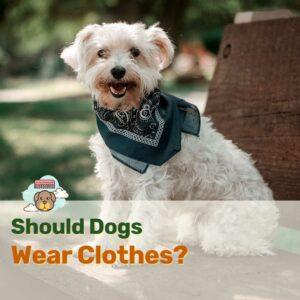The idea of dogs wearing clothes can sometimes seem unnecessary or even cruel to some. Therefore raising the question “Should Dogs Wear Clothes?”.
But, beyond the realm of social media cuteness and the occasional eye-catching costume, clothing for dogs or puppies serves functional and protective purposes, especially during the winter months or for indoor pets.
Benefits of Dogs Wearing Clothes
1) Functional Wear for Various Needs
Dogs, like us, may require additional layers to cope with various environmental challenges:
- Winter Garments: In colder climates, sweaters and coats help keep dogs, particularly those with short fur, warm during winter walks.
How do you know if your dog is cold?
Look for signs like shivering, hunching, and reluctance to walk. Dogs with thin coats, small breeds, and older dogs are more susceptible to cold. - Anxiety Vests and Thundershirts: These can significantly soothe a dog’s anxiety, helping them sleep more peacefully during stressful situations like thunderstorms.
- Cooling Vests for Summer Heat: To counteract the scorching summer heat, these vests are essential for regulating body temperature.
- Protective Booties: These safeguard a dog’s paws from hot surfaces in the summer and harmful substances like ice-melting salts in the winter.
- Life Jackets: A must-have for water activities, ensuring safety and buoyancy.
2) Preventing Dirt on Indoor Dogs
For indoor dogs, wearing a coat or sweater outdoors can protect their fur from dirt and reduce the frequency of baths needed.
3) Safety during Night Walks
Reflective clothing is a boon for night walks, enhancing visibility and safety.
Choosing the Right Dog Clothes
Fit and Comfort
Proper measurement is key. Clothes should fit snugly but not too tightly, especially around their neck and chest.
Avoid human clothes or human T-shirts as they’re not designed for a dog’s body shape and can cause discomfort or movement restriction.
Material and Design
Select materials that are gentle on your dog’s skin and easy for them to move in. Designs that are easy to put on and take off are ideal.
Risks with Costumes and Other Clothing
While dressing up dogs can be fun, there are risks involved:
Allergic Reactions and Health Issues
As highlighted in a study by KBV Research, some fabrics can cause allergic reactions, leading to discomfort, itching, and even skin conditions. It’s crucial to monitor your dog for any signs of discomfort or allergies.
Additionally, as reported by The Post and Courier, pets that consume pieces of clothing can face serious health issues. Ensure that any clothing is secure and doesn’t have parts that can easily be chewed off.
Monitoring Your Dog’s Reaction
Always observe your dog’s behavior when they’re wearing clothes.
Signs of distress, like persistent scratching or trying to remove the clothing, indicate that the outfit may not be suitable for them.
Conclusion: Should Dogs Wear Clothes?
While dressing up your dog, especially in winter or for night walks, can be both functional and fun, it’s important to prioritize their comfort and safety.
Clothes should never be so tight as to restrict movement, especially around their neck, and should always be made of dog-friendly materials.
As long as your dog seems happy and comfortable, whether in a fancy costume or a simple protective vest, you’re doing it right. Remember, the goal is to enhance their well-being, not compromise it.
Editor’s Recommendations:






